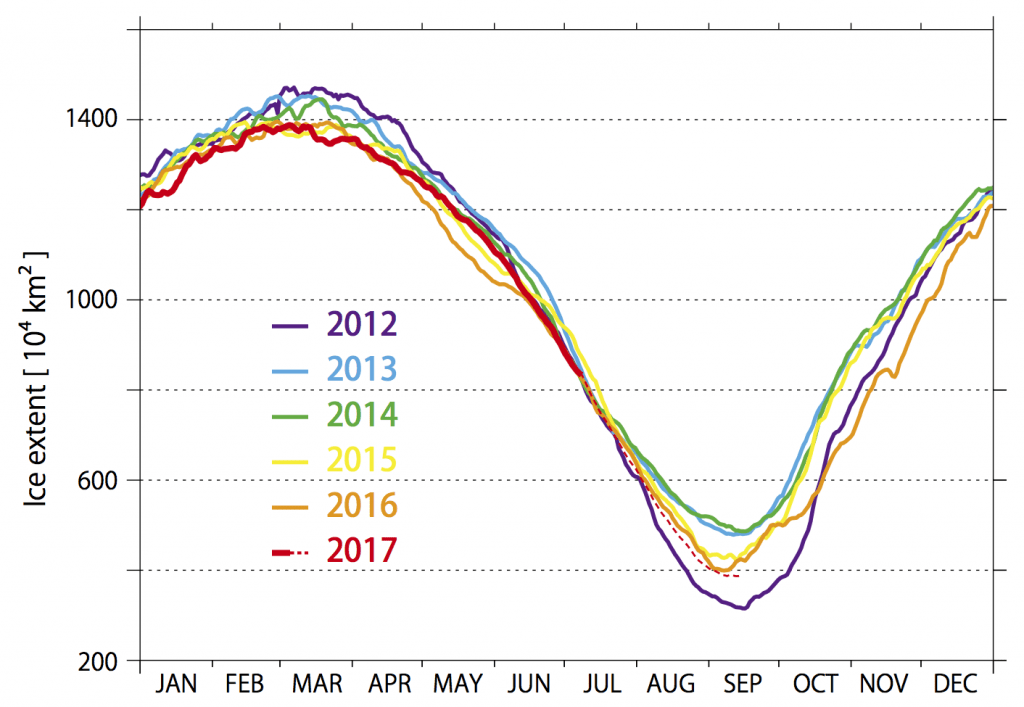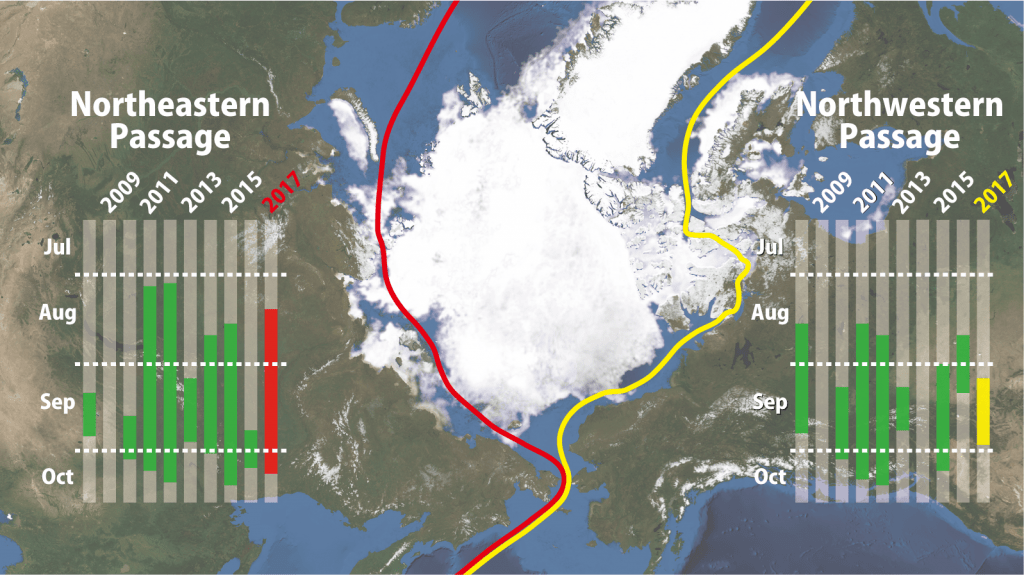News & Press Release
Weathernews Announces 2017 Arctic Sea Ice Outlook
Faster Melt-off than Normal, 2nd Lowest Extent on Record
NE Passage Open from Mid-August, NW Passage Open from Early September
Shipping >The Global Ice Center at Weathernews Inc. (Chiba, Japan; CEO: Chihito Kusabiraki) has released its Arctic sea ice forecast for the summer of 2017. The ice in the Arctic Ocean is receding at a faster rate than average, and is forecast to become the second recorded lowest extent. The Northeast Passage (Russian side) is expected to open in mid-August whereas the Northwest Passage (Canadian side) is expected to open in early September. In recent years, Russian LNG development projects have become more active, and the Northern Sea Route is expected to be utilized for the transportation of construction materials and modules from the Far East and transportation of LNG after production commences, resulting in heightened needs for high-precision sea ice information for safe navigation. On July 14th, Weathernews launched a micro-satellite known as WNISAT-1R, in order to gain further insight into the distribution of sea ice to support safe voyages.
2017 Arctic Ocean Sea Ice Outlook
The current Arctic ice extent is 8 million km2 and is melting at a faster pace than the average year. By mid-September it is forecast to reduce to 3.9 million km2 for the second lowest recorded surface area, behind 2012 which had 3.28 million km2.

(2017 is based on a forecast)
The melting is especially fast along the Russian coast, with open water appearing at a record pace in the Chukchi Sea, especially around the Bering Strait. It is believed that this is due to the flow sea ice being strong from winter into spring, allowing the sea ice to melt easier than usual. On the other hand, ice along the Canadian coast and around Greenland remains more than average, with more severe conditions than usual during this season. One reason is that due to global warming, the sea ice in the Arctic Ocean is on a long-term downward trend, and the ice is more mobile than before. This allows sea ice from the high latitudes to move southward.
The ice is forecast to continue melting, with open waters across the Russian coast being linked east to west by mid-August, allowing the Northeast Passage to open a month earlier than last year, when the opening was delayed. The Canadian coast is expected to also become mostly ice-free by early September, allowing the Northwest Passage to open.
*’Open’ is defined as a state (judged to from satellite data) where a vessel can sail the Northern Sea Route via any passage without hitting sea ice.

Ice Extent Minimum Rankings | |
1st | 2012: 3,280,000 km2 |
2nd | 2017: 3,900,000 km2 |
3rd | 2016: 4,020,000 km2 |
4th | 2007: 4,070,000 km2 |
Lowest Recorded Ice Extents
(2017 is based on a forecast)
Weathernews Original Satellite WNISAT-1R Launched on July 14, 2017
Ever since statistics started to be taken in 1979, the extent of sea ice in the Arctic Ocean has been on a long-term downward trend, with the Northern Sea Routes becoming utilized more. In addition, in recent years, Russian LNG development projects have become more active, and the Northern Sea Route is expected to be utilized for the transportation of construction materials and modules from the Far East and transportation of LNG after production commences, resulting in heightened needs for high-precision sea ice information for safe navigation. According to the Northern Sea Route Administration in Russia, the number of voyages permitted to sail via the Northeast Passage has already exceeded 390, about the same pace as last year.
Weathernews began Polar Routeing Service in 2011 in order to support vessels transiting the Arctic Ocean. Multiple satellites are used to analyze the ice conditions along the route, and the weather risks along the recommended route are communicated to the vessel and shore side operators. Recent track records are 12 voyages supported in 2015 and 88 voyages were supported in 2016. With the launch of the Weathernews proprietary satellite WNISAT-1R on July 14th of this year, service quality will be improved due to more detailed sea ice information.